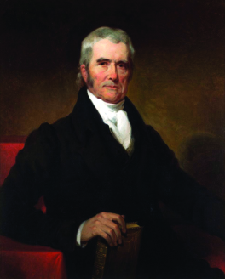| << Chapter < Page | Chapter >> Page > |

This ruling established the doctrine of implied powers, granting Congress a vast source of discretionary power to achieve its constitutional responsibilities. The Supreme Court also sided with the federal government on the issue of whether states could tax federal property. Under the supremacy clause of Article VI , legitimate national laws trump conflicting state laws. As the court observed, “the government of the Union, though limited in its powers, is supreme within its sphere of action and its laws, when made in pursuance of the constitution, form the supreme law of the land.” Maryland’s action violated national supremacy because “the power to tax is the power to destroy.” This second ruling established the principle of national supremacy, which prohibits states from meddling in the lawful activities of the national government.
Defining the scope of national power was the subject of another landmark Supreme Court decision in 1824. In
Gibbons v. Ogden , the court had to interpret the commerce clause of
Article I , Section 8; specifically, it had to determine whether the federal government had the sole authority to regulate the licensing of steamboats operating between New York and New Jersey.
Various states railed against the nationalization of power that had been going on since the late 1700s. When President John
Adams signed the
Sedition Act in 1798, which made it a crime to speak openly against the government, the Kentucky and Virginia legislatures passed resolutions declaring the act null on the grounds that they retained the discretion to follow national laws. In effect, these resolutions articulated the legal reasoning underpinning the doctrine of
nullification —that states had the right to reject national laws they deemed unconstitutional.

Notification Switch
Would you like to follow the 'American government' conversation and receive update notifications?